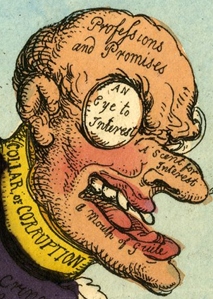All 1 entries tagged Free
View all 30 entries tagged Free on Warwick Blogs | View entries tagged Free at Technorati | There are no images tagged Free on this blog
January 10, 2015
Satire, Corruption, and Religious Parody
 The extent to which free speech includes a right to offend religious sensibilities is now being much debated in the light of the murder of French satirists at Charlie Hebdo in Paris.
The extent to which free speech includes a right to offend religious sensibilities is now being much debated in the light of the murder of French satirists at Charlie Hebdo in Paris.
Similar issues were raised in 1817 by the prosecution of the British radical publisher and writer William Hone for parodying Christian worship in his satires against what he saw as widespread corruption in the period after the end of the Napoleonic wars.
Hone published three parodies of the creed, litany and catechism, using satire in order to press the case for the reform of corruption. The Sincecurist’s Creed, for example, parodied the code of religious belief to mock those who seemed to be paid by the state for work they did not do and yet voted religiously with the government:
WHOSOEVER will be a Sinecurist: before all things it is necessary that he hold a place of profit.
Which place except every Sinecurist do receive the salary for, and do no service: without doubt it is no Sinecure.
And a Sinecurist's duty is this: that he divide with the Ministry, and be with the Ministry in a Majority
Hone admitted having ‘an irresistible propensity to humour’. But the government clearly did not share his sense, since it charged him with blasphemy for each of the three tracts. At the heart of the government’s position was the principle that Scripture should be ‘never used for secular purposes’. Hone, defending himself throughout the three extremely gruelling trials, saw himself as a martyr for free speech. He argued that ‘if there was ridicule, those who rendered themselves ridiculous’ could not complain of libel; and that there was a long history of religious texts being used for parody (indeed, he accumulated a very large collection of such texts, stretching back to the Protestant reformation of the sixteenth century). He included visual parody in his catalogue. He also suggested that there were two types of parody: ‘one in which a man might convey ludicrous or ridiculous ideas relative to some other subject; the other, where it was meant to ridicule the thing parodied. The latter was not the case here, and therefore he had not brought religion into contempt’. He also suggested that the government was extremely hypocritical, since one of its own cabinet ministers, George Canning, had recently parodied a religious text for political purposes. Hone produced text after text in court to prove his points and was found not-guilty in each of the three trials.
Hone continued to use satire to attack corruption, though his next most important – and best-selling - publication parodied a nursery rhyme rather than Scripture to make its point. The House that Jack Built (1819) lampooned the government for building a corrupt House; but it also featured a picture of the printing press as ‘THE THING’ which could ‘poison the vermin’ who plundered the wealth of the nation.
Hone, ironically, became more religious in his later years and, aware of the offence it caused, did not use religious satire again. But the very long lists of religious parodies that he produced in court stood to highlight how important religious parody was to the Protestant tradition. Luther himself parodied the Psalms, as had eminent reformers in England. As Hone put it, parody ‘had been followed by the most venerable and respected characters this country ever produced’.
 Mark Knights
Mark Knights

 Please wait - comments are loading
Please wait - comments are loading

 Loading…
Loading…

